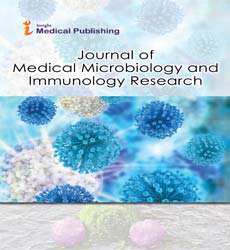ISSN : 2634-7164
Journal of Medical Microbiology and Immunology Research
Anti-dyslipidemic potential evaluation of garden snail slime using zebra fish
Abstract
Dyslipidemia is one of the lipid-storage disorders which leads to variousheart related diseases. Protein -Protein interaction networkofdyslipidemic proteins reveal the sets of biomarkers which are highlynotable for target studies. List of genes involved in this disorder areretrieved from DisGeNET Database, in which the genes scored morethan0.699 in Disease specific index are selected to create networkusingSTRING. Among 216 genes, 204 genes are involved in network. Thehighly interacted nodes such as APOC2, APOE, AHSG, IL6, AGTandGNB3 are chosen for docking studies with identified snail slimecompounds which are identified by GC-MS studies. Snail slime is anexternal mucus secretion of snail from its pedal gland produced for itself-defence, locomotion and lubrication. Due to the Major constituents ofsnail slime include Proteoglycans, Glycosaminoglycans, Glycoproteinenzymes, Hyaluronic acid, Copper peptides, Anti-microbial peptides and metal ions, the slime has been used in many industrial purposes suchascosmetic and drug industries. In recent research, Zebrafish (Daniorerio) is considered an important model for drug discovery, development, and preclinical studies. In this Anti-lipidemic research in high cholesterol-induced fish with predefined slime, feed supports that the slime has proven lipid-lowering capacity in the liver homogenate of 25days fed fish. In a conclusion, our insilico studies followed byinvitroresearch suggest that 7 percent of slime in normal feed controls lipiddeposition in organs.
Open Access Journals
- Aquaculture & Veterinary Science
- Chemistry & Chemical Sciences
- Clinical Sciences
- Engineering
- General Science
- Genetics & Molecular Biology
- Health Care & Nursing
- Immunology & Microbiology
- Materials Science
- Mathematics & Physics
- Medical Sciences
- Neurology & Psychiatry
- Oncology & Cancer Science
- Pharmaceutical Sciences
